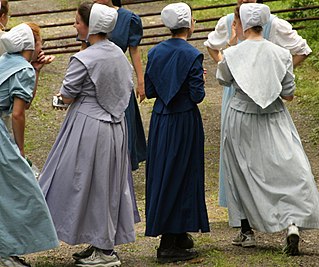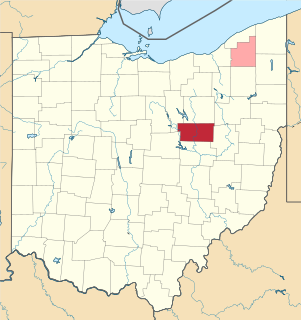
Mennonites are members of certain Christian groups belonging to the church communities of Anabaptist denominations named after Menno Simons (1496–1561) of Friesland. Through his writings, Simons articulated and formalized the teachings of earlier Swiss founders, with the early teachings of the Mennonites founded on the belief in both the mission and ministry of Jesus, which the original Anabaptist followers held with great conviction, despite persecution by various Roman Catholic and Protestant states. Mennonite beliefs were codified in the Dordrecht Confession of Faith in 1632, which affirmed "the baptism of believers only, the washing of the feet as a symbol of servanthood, church discipline, the shunning of the excommunicated, the non-swearing of oaths, marriage within the same church, strict nonresistance, and in general, more emphasis on true Christianity involving being Christian and obeying Christ".

Pennsylvania Dutch, referred to as Pennsylvania German in scholarly literature, is a variety of West Central German spoken by the Old Order Amish, Old Order Mennonites and other descendants of German immigrants in the United States and Canada, closely related to the Palatine dialects. There are possibly more than 300,000 native speakers of Pennsylvania Dutch in the United States and Canada.

The Old Order River Brethren are a River Brethren denomination of Anabaptist Christianity with roots in the Radical Pietist movement. As their name indicates, they are Old Order Anabaptists.
The Conservative Mennonite Conference (CMC) is a Christian body of Conservative Mennonite churches in the Anabaptist tradition. Its members are mostly of Amish descent.

Old Order Mennonites form a branch of the Mennonite tradition. Old Order are those Mennonite groups of Swiss German and south German heritage who practice a lifestyle without some elements of modern technology, who still drive a horse and buggy rather than cars, wear very conservative and modest dress plainly and who have retained the old forms of worship, baptism and communion.
Behalt is a 10-by-265-foot cyclorama painted by Heinz Gaugel in the late 20th century. The name comes from the German word behalten: to hold onto or to remember. The work illustrates the heritage of the Amish and Mennonite people from the beginnings of Christianity and is displayed in the Amish and Mennonite Heritage Center in Berlin, Holmes County, Ohio. The Columbus Dispatch said it was the "Sistine Chapel of the Amish and Mennonites". One of four existing cycloramas in the US and one of only 16 in the world, Behalt is the only existing cyclorama painted by a single artist.
Donald B. Kraybill is an American author, lecturer, and educator on Anabaptist faiths and culture. Kraybill is widely recognized for his studies on Anabaptist groups and in particular the Amish. He has researched and written extensively on Anabaptist culture. He is Distinguished Professor Emeritus at Elizabethtown College and Senior Fellow Emeritus at Elizabethtown's Young Center for Anabaptist and Pietist Studies.

Amish Mennonites came into existence through reform movements among North American Amish mainly between 1862 and 1878. These Amish moved away from the old Amish traditions and drew near to the Mennonites, becoming Mennonites of Amish origin. Over the decades, most Amish Mennonites groups removed the word "Amish" from the name of their congregations or merged with Mennonite groups.
Raber's New American Almanac is an almanac used by many Old Order Amish, published by an Amish bookstore in Baltic, Ohio. The German edition has been published since 1930, and the English edition since the 1970s; both have a plain black and white cover. It includes a register of all the Amish ministers in America, listed by state, community, and church district, a calendar of Bible verses and hymns which will be used in worship services, and traditional weather and planting forecasts.

The Beachy Amish Mennonites, also known as the Beachy Mennonites, are an Anabaptist group of churches in the Conservative Mennonite tradition that have Amish roots. Although they have retained the name "Amish" they are quite different from the Old Order Amish: they do not use horse and buggy for transportation, with a few exceptions they do not speak Pennsylvania German anymore, nor do they have restrictions on technology except for radio and television. In the years 1946 to 1977 a majority was transformed into an evangelical revivalist denomination. The traditionalists who wanted to preserve the old Beachy Amish ways then withdrew and formed their own congregations. Today they are known as Midwest Beachy Amish Mennonites or Old Beachy Amish.
The Fellowship of Evangelical Churches (FEC) is an evangelical body of Christians with an Amish Mennonite heritage that is headquartered in Fort Wayne, Indiana, United States. It contains 60 churches located in Colorado, Idaho, Illinois, Indiana, Kansas, Maine, Michigan, Minnesota, Missouri, Ohio, and Pennsylvania.

The Amish, formally the Old Order Amish, are a group of traditionalist Anabaptist Christian church fellowships with Swiss German and Alsatian origins. They are closely related to Mennonite churches, another Anabaptist denomination. The Amish are known for simple living, plain dress, Christian pacifism, and slowness to adopt many conveniences of modern technology, with a view neither to interrupt family time, nor replace face-to-face conversations whenever possible, and a view to maintain self-sufficiency. The Amish value rural life, manual labor, humility, and Gelassenheit, all under the auspices of living what they interpret to be God's word.
The Swartzentruber Amish are the best-known and one of the largest and most conservative subgroups of Old Order Amish. Swartzentruber Amish are considered a subgroup of the Old Order Amish, although they do not fellowship or intermarry with more liberal Old Order Amish. They speak Pennsylvania German as their mother tongue as well as English.

Conservative Mennonites include numerous Conservative Anabaptist groups that identify with the theologically conservative element among Mennonite Anabaptist Christian fellowships, but who are not Old Order groups or mainline denominations.
Subgroups of Amish developed over the years, as Amish churches have divided many times over doctrinal disputes. The 'Old Order' Amish, a conservative faction that withdrew from fellowship with the wider body of Amish in the 1860s, are those that have most emphasized traditional practices and beliefs. There are many different subgroups of Amish with most belonging, in ascending order of conservatism, to the Beachy Amish, New Order, Old Order, or Swartzentruber Amish groups.
The Noah Hoover Mennonites, called "Old Order Mennonite Church (Hoover)" by the Mennonite World Conference, and sometimes called "Scottsville Mennonites”, are a group of very plain Old Order Mennonites that originally came from the Stauffer Mennonites and later merged with several other groups. Today it is seen as an independent branch of Old Order Mennonites. The group differs from other Old Order Mennonites by having settlements outside the US and Canada and by attracting new members from other groups on a larger scale. They have more restrictions on modern technology than all other Old Order Mennonite groups. They are rather intentionalist minded than ultra traditional.
Stephen Scott was an American writer on Anabaptist subjects, especially on Old Order and Conservative Mennonite groups.

Old Order Anabaptism encompasses those groups which have preserved the old ways of Anabaptist Christian religion and lifestyle.

The Amish and Mennonite Heritage Center is located at 5798 County Road 77 near Bunker Hill in Berlin, Holmes County, Ohio. It houses the Behalt cyclorama, one of a handful of remaining cycloramas worldwide and the only one painted by a single artist. The cyclorama presents the history of Anabaptism.

The Amish in Ohio are the second-largest population of Old Order Amish in the world, with in 2021 an estimated 80,240 members according to the Young Center for Anabaptist and Pietist Studies at Elizabethtown College. Ohio's largest settlement is centered around Holmes County and in 2021 included an estimated 37,770 children and adults, the second largest in the world and the highest concentration of Amish in any US county; the Amish make up half the population of Holmes County. The second largest community in Ohio is centered around Geauga County.








